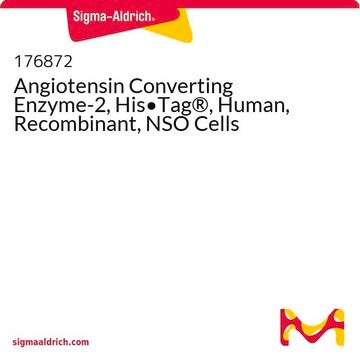SAE0171
Angiotensin Converting Enzyme-2, ACE2
biotin-tagged, human recombinant, ≥1000000U/mg, expressed in HEK 293 cells
Synonym(s):
ACE-related carboxypeptidase, ACE2, Angiotensin-converting enzyme homolog (ACEH), COVID-19 receptor, Metalloprotease MPROT15, SARS-COV2 receptor
Sign Into View Organizational & Contract Pricing
All Photos(5)
About This Item
UNSPSC Code:
12352204
NACRES:
NA.83
Recommended Products
recombinant
expressed in HEK 293 cells
Quality Level
description
Biotinylation: ≥90% (gel shift assay)
Assay
≥95% (SDS-PAGE)
specific activity
≥1000000 U/mg
shipped in
wet ice
storage temp.
−20°C
General description
Angiotensin Converting Enzyme-2 (ACE2) is a membrane-associated and secreted enzyme that is principally expressed on endothelium. In humans, ACE2 occurs mainly in endothelium of heart, kidney, and testis, with other expression in coronary vessel smooth muscle and kidney tubular epithelium ACE2 is a component of the renin-angiotensin system (RAS) that provides protective effects in peripheral tissues.
Coronaviruses such as SARS-CoV-2 and SARS-CoV-1 use the host ACE2 as a co-receptor to gain intracellular entry into the lungs and brain. The virion expresses a protein termed spike, which directly binds to the extracellular domain of ACE2. A specific region in the spike protein serves as the receptor binding domain (RBD). The ACE2:spike interaction has a high affinity of 15 nM.
Recombinant human ACE2 is expressed in human HEK 293 cells as a glycoprotein with a C-terminal FLAG® tag and his-tag with a calculated molecular mass of 85.9 kDa. The DTT-reduced protein migrates as a 90–120 kDa polypeptide on SDS-PAGE due to glycosylation.
This ACE2 is labelled with biotin, to form Angiotensin Converting Enzyme-2. This ACE2 biotin-tagged may serve as a useful tool for binding experiments while detecting protein: protein interaction assays using binding partners such as CoV spike protein. The degree of biotinylation is ≥90%. This ACE2-biotin can be visualized with streptavidin-conjugated probes (e.g., Streptavidin, HRP conjugate catalog No. 18-152).
Coronaviruses such as SARS-CoV-2 and SARS-CoV-1 use the host ACE2 as a co-receptor to gain intracellular entry into the lungs and brain. The virion expresses a protein termed spike, which directly binds to the extracellular domain of ACE2. A specific region in the spike protein serves as the receptor binding domain (RBD). The ACE2:spike interaction has a high affinity of 15 nM.
Recombinant human ACE2 is expressed in human HEK 293 cells as a glycoprotein with a C-terminal FLAG® tag and his-tag with a calculated molecular mass of 85.9 kDa. The DTT-reduced protein migrates as a 90–120 kDa polypeptide on SDS-PAGE due to glycosylation.
This ACE2 is labelled with biotin, to form Angiotensin Converting Enzyme-2. This ACE2 biotin-tagged may serve as a useful tool for binding experiments while detecting protein: protein interaction assays using binding partners such as CoV spike protein. The degree of biotinylation is ≥90%. This ACE2-biotin can be visualized with streptavidin-conjugated probes (e.g., Streptavidin, HRP conjugate catalog No. 18-152).
Application
- Exploration of the protein protein interaction of ACE2 with is partners, like COV Spike protein.
- Tool for screening inhibitors for the interaction of ACE2 with COV Spike protein
Biochem/physiol Actions
Angiotensin Converting Enzyme-2 (ACE2) is a membrane-associated and secreted enzyme, that is expressed predominantly on endothelium. In humans, it is highly restricted to heart, kidney, and testis.
ACE2 is a new component of the renin-angiotensin system (RAS). It provides protective effects in peripheral tissues and has great potential for the treatment of RAS-related diseases.
Coronaviruses such as SARS-CoV-2 and SARS-CoV-1 use the host ACE2 as a coreceptor to gain intracellular entry into the lungs and brain. The virion expresses a protein termed spike, which directly binds to the extracellular domain of ACE2. A specific region in the spike protein serves as the receptor binding domain (RBD). The ACE2:spike interaction has a high affinity of 15 nM.
ACE2 is a new component of the renin-angiotensin system (RAS). It provides protective effects in peripheral tissues and has great potential for the treatment of RAS-related diseases.
Coronaviruses such as SARS-CoV-2 and SARS-CoV-1 use the host ACE2 as a coreceptor to gain intracellular entry into the lungs and brain. The virion expresses a protein termed spike, which directly binds to the extracellular domain of ACE2. A specific region in the spike protein serves as the receptor binding domain (RBD). The ACE2:spike interaction has a high affinity of 15 nM.
Features and Benefits
Our biotin-tagged ACE2 enables exploration of the ACE2 interaction with Spike protein of SARS-COV-2
Unit Definition
One unit is defined as the amount of enzyme required to cleave 1 picomole of the fluorogenic peptide substrate, Mca-YVADAPK(Dnp)-OH in one minute, in 37 °C, pH 7.5.
Other Notes
This product is supplied as a powder, lyophilized from a 0.22 μm filtered solution in PBS, pH 7.4. The specific activity of recombinant ACE2 is measured by its ability to cleave a fluorogenic peptide substrate, Mca-YVADAPK(Dnp)-OH.
Legal Information
FLAG is a registered trademark of Merck KGaA, Darmstadt, Germany
Storage Class Code
11 - Combustible Solids
WGK
WGK 2
Certificates of Analysis (COA)
Search for Certificates of Analysis (COA) by entering the products Lot/Batch Number. Lot and Batch Numbers can be found on a product’s label following the words ‘Lot’ or ‘Batch’.
Already Own This Product?
Find documentation for the products that you have recently purchased in the Document Library.
Our team of scientists has experience in all areas of research including Life Science, Material Science, Chemical Synthesis, Chromatography, Analytical and many others.
Contact Technical Service








